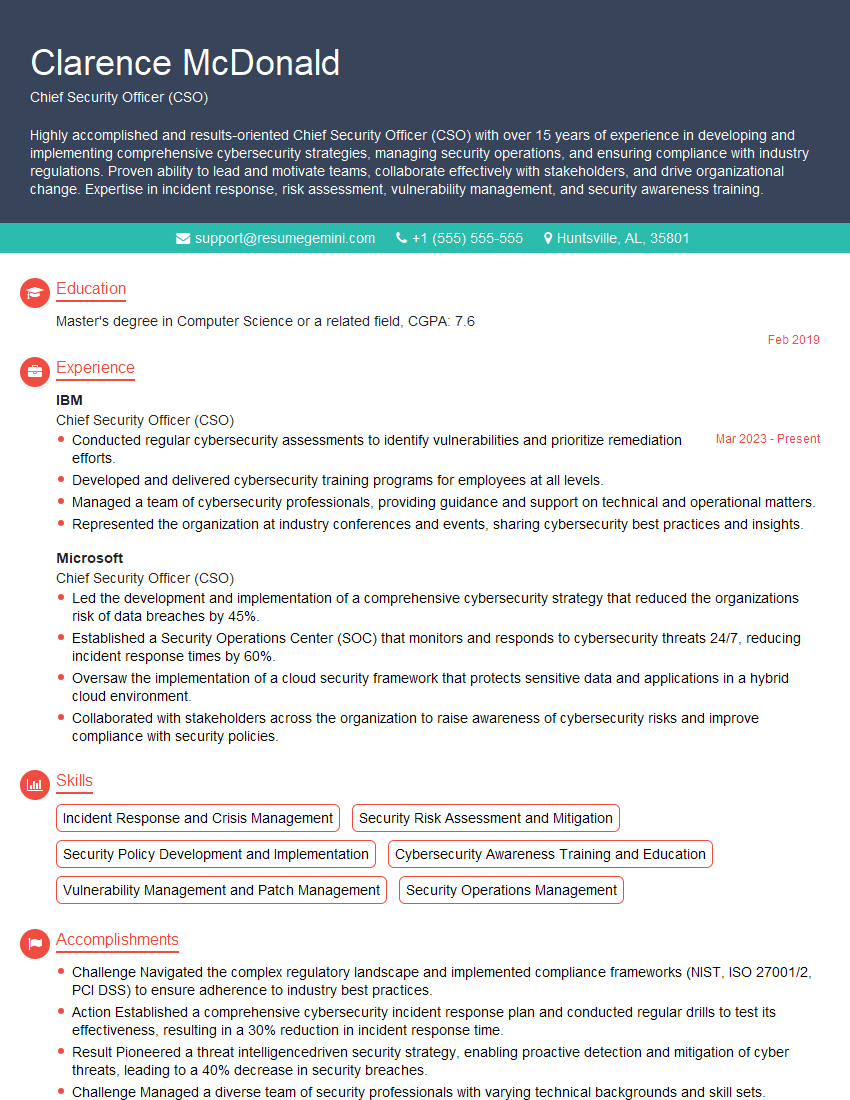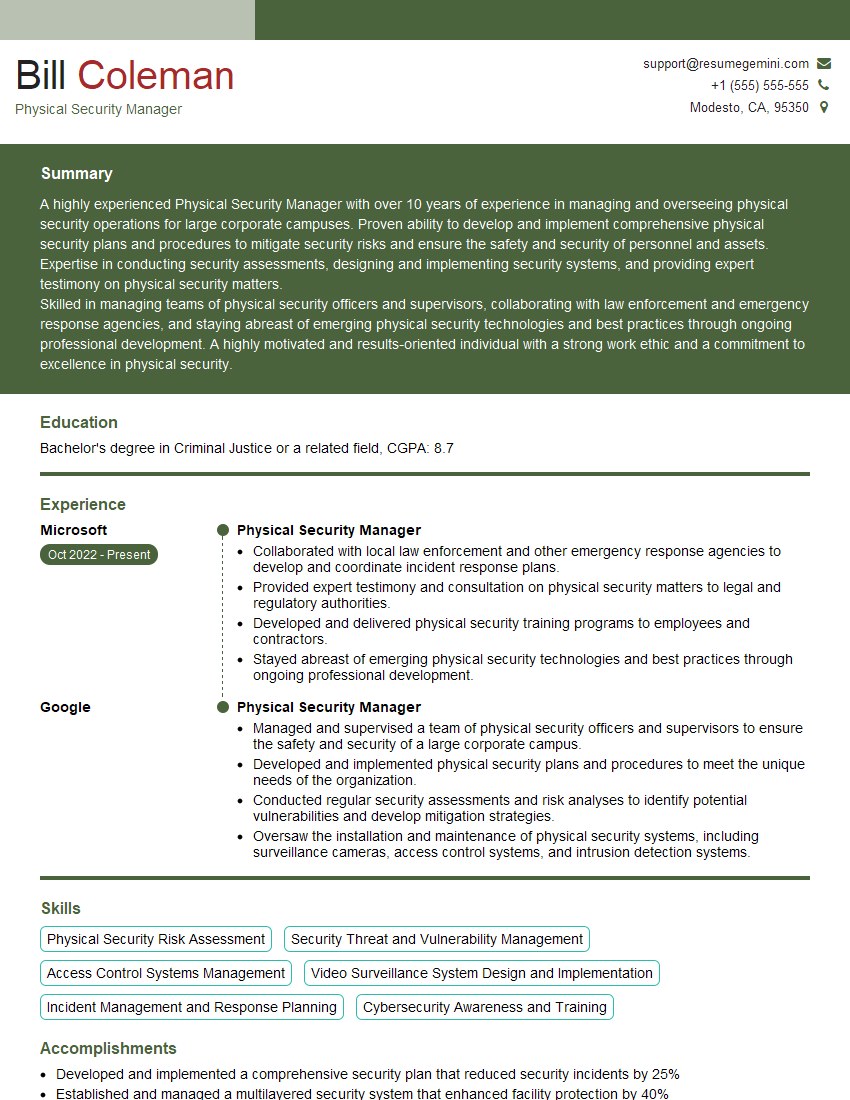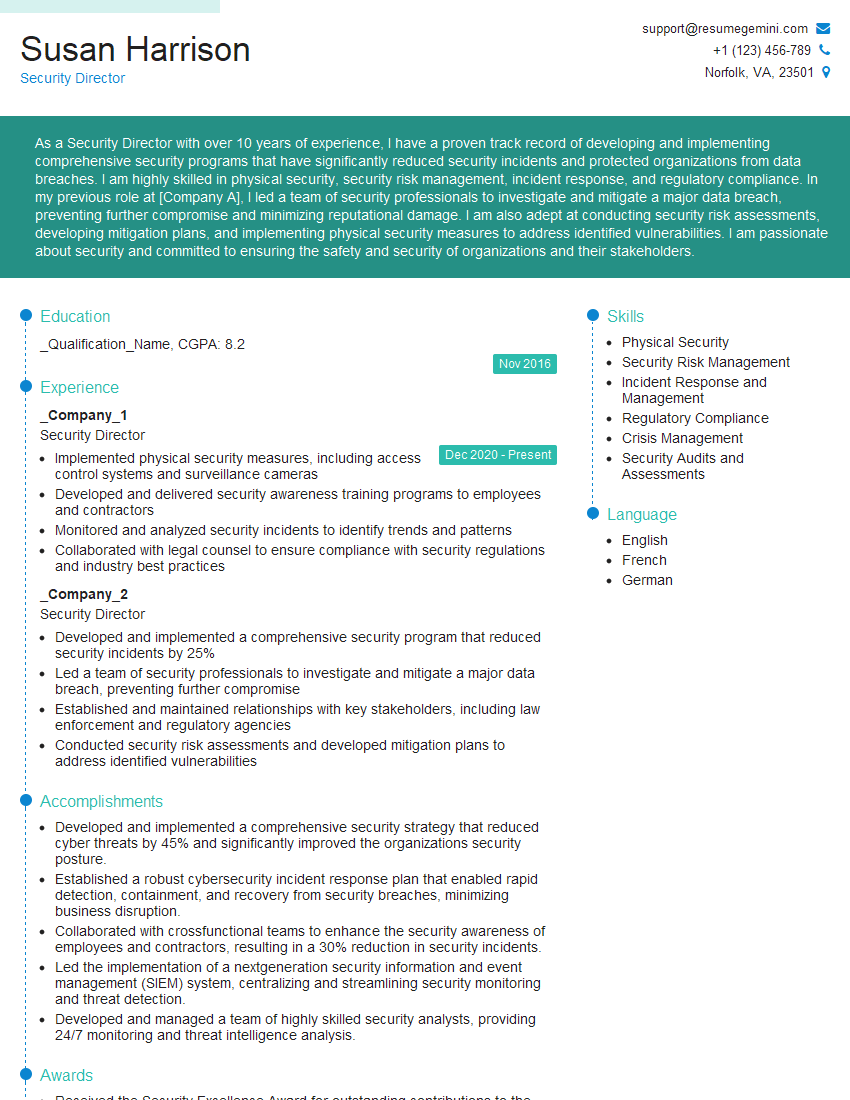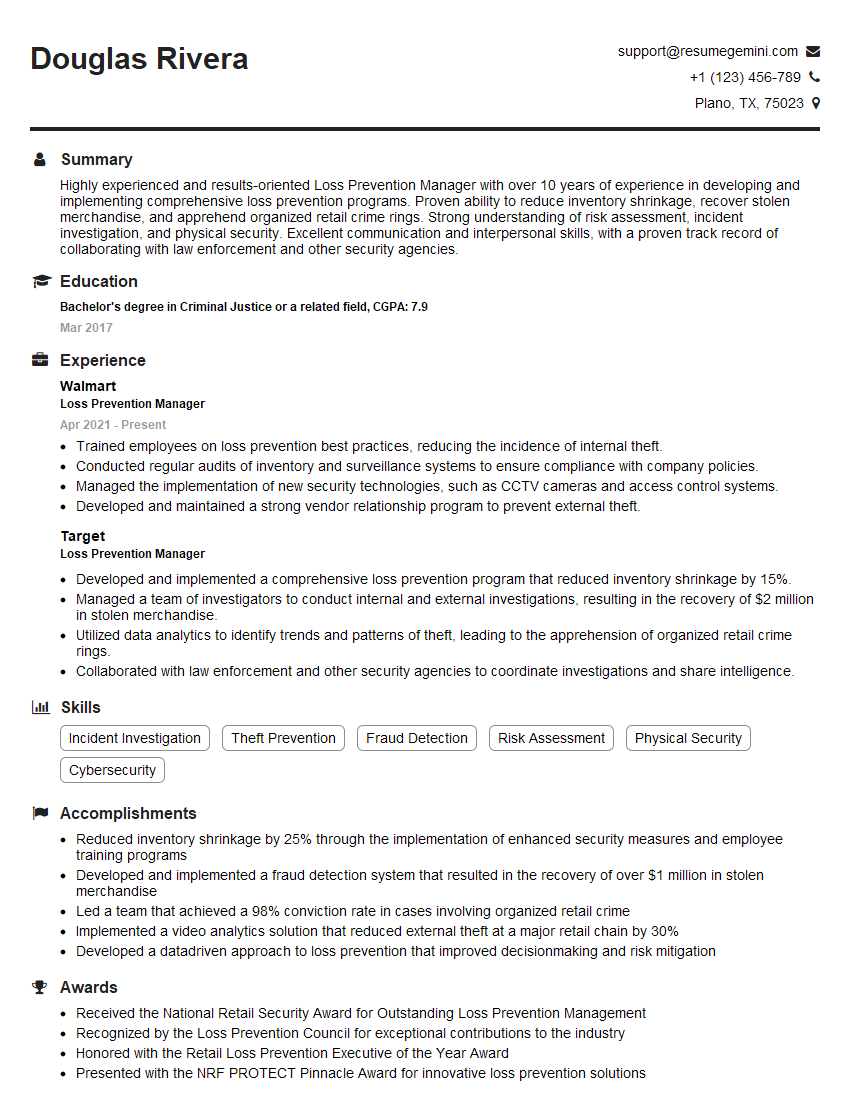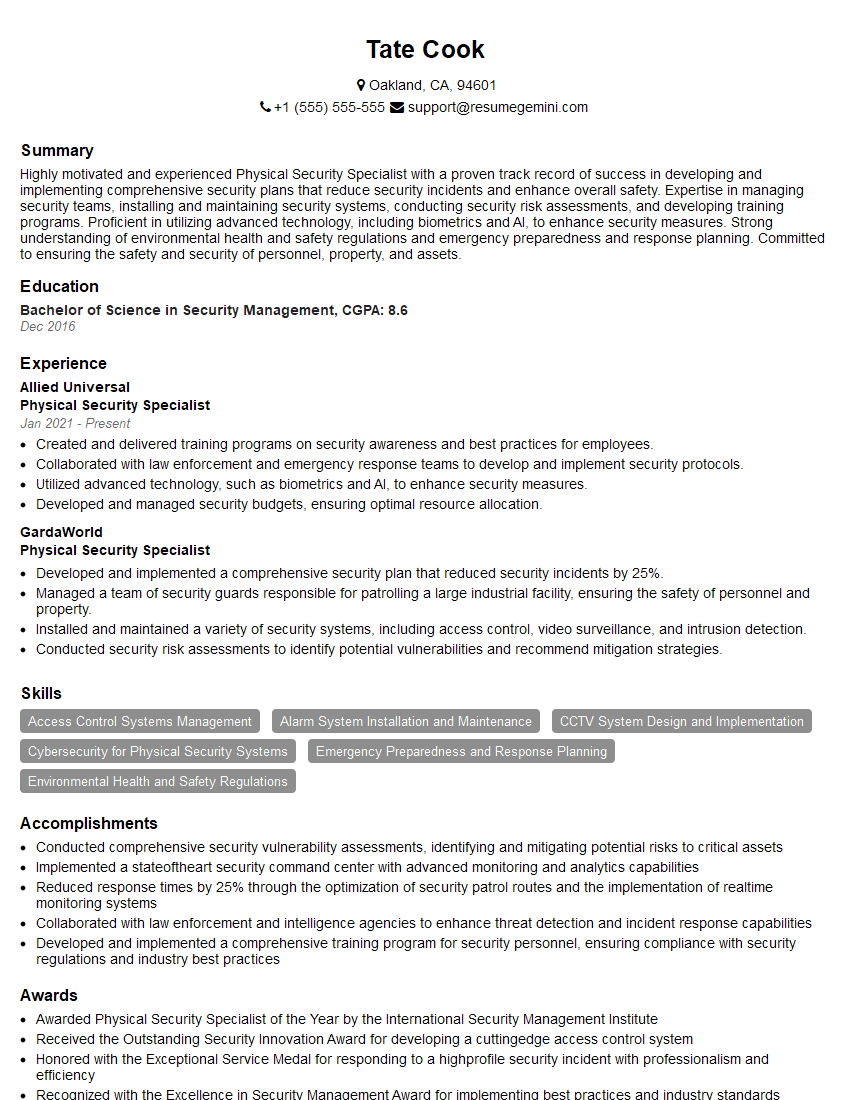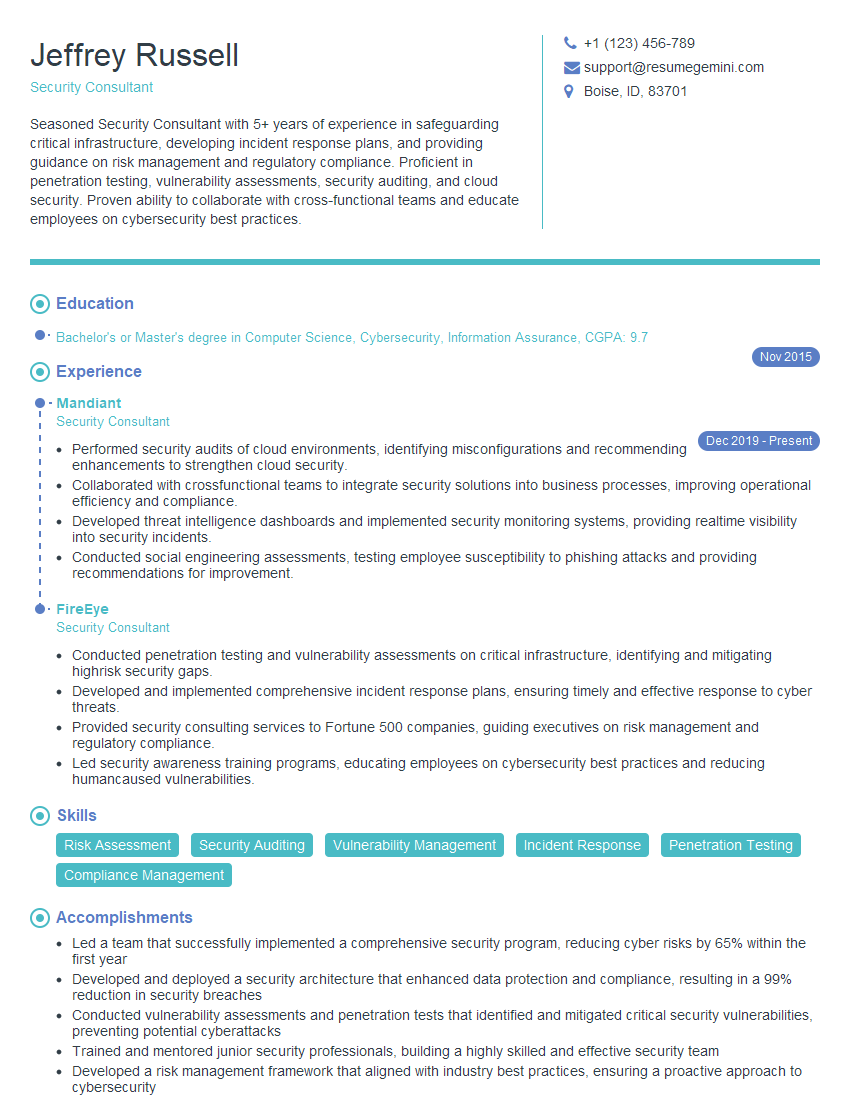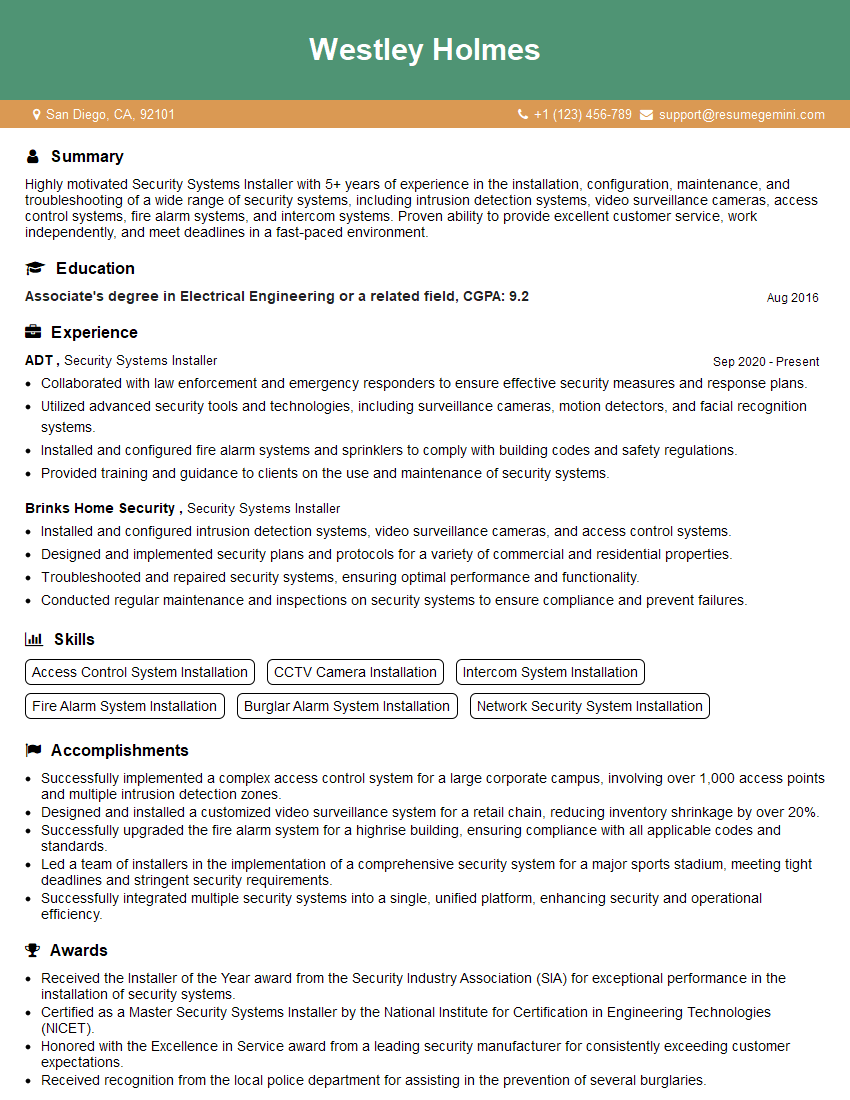Feeling uncertain about what to expect in your upcoming interview? We’ve got you covered! This blog highlights the most important Physical Security and Risk Mitigation interview questions and provides actionable advice to help you stand out as the ideal candidate. Let’s pave the way for your success.
Questions Asked in Physical Security and Risk Mitigation Interview
Q 1. Describe your experience with implementing access control systems.
Implementing access control systems involves a multi-faceted approach that prioritizes security while maintaining ease of use. My experience spans various systems, from simple keycard readers to complex biometric and multi-factor authentication setups. I’ve worked on projects involving the installation, configuration, and maintenance of access control systems in diverse environments, including office buildings, data centers, and manufacturing facilities.
For instance, in a recent project for a pharmaceutical company, we implemented a tiered access control system. This involved assigning different access levels based on job roles and the sensitivity of the areas. Scientists working with sensitive compounds had restricted access, while administrative staff had access to common areas. We used a combination of card readers, biometric scanners, and time-clock functionality, all integrated into a centralized management system for comprehensive monitoring and reporting. This system not only enhanced security but also streamlined access management, reducing administrative overhead.
Another example involved designing a system for a high-security data center that incorporated multi-factor authentication, including smart cards and one-time passwords, combined with robust auditing capabilities to track all access attempts. I carefully considered the trade-offs between security and user experience, ensuring a system that was both secure and user-friendly.
Q 2. Explain your understanding of risk assessment methodologies (e.g., NIST, ISO 27005).
Risk assessment methodologies, like NIST Cybersecurity Framework and ISO 27005, provide structured approaches to identifying, analyzing, and prioritizing security risks. They both emphasize a systematic approach, though their specific processes vary slightly. Both frameworks typically involve the following steps:
- Asset Identification: Identifying all assets, both physical and digital, that need protecting.
- Threat Identification: Identifying potential threats that could compromise these assets (e.g., theft, fire, cyberattacks).
- Vulnerability Identification: Determining weaknesses in security controls that could allow threats to succeed.
- Risk Analysis: Assessing the likelihood and potential impact of each identified risk.
- Risk Response: Developing strategies to mitigate identified risks (e.g., implementing controls, transferring risk through insurance).
- Monitoring and Review: Regularly reviewing and updating the risk assessment process.
My experience involves leveraging these methodologies to conduct thorough risk assessments. I’m proficient in using both qualitative and quantitative methods to analyze risk, and I’m comfortable tailoring my approach to the specific needs of an organization and its risk appetite. The choice between NIST and ISO 27005 often depends on regulatory requirements and organizational preferences.
Q 3. How would you design a security plan for a high-value asset?
Designing a security plan for a high-value asset demands a layered approach, incorporating multiple security measures to prevent unauthorized access and mitigate potential threats. The plan would need to consider the unique vulnerabilities of the asset and the potential threats.
- Physical Security: This includes robust physical barriers like fences, walls, and secure doors; surveillance systems (CCTV) with monitoring; access control systems with strict authorization protocols; alarm systems with integrated response capabilities; environmental controls to protect against fire or flood.
- Cybersecurity: If the asset has a digital component, this requires strong network security, intrusion detection systems, regular vulnerability scans, and robust data encryption.
- Personnel Security: Thorough background checks, strict access controls based on roles, security awareness training, and strict protocols regarding handling the asset are crucial.
- Insurance and Contingency Planning: Insurance coverage for loss or damage, along with detailed contingency plans for emergency situations, are necessary.
For example, a security plan for a high-value artwork would involve climate-controlled storage with surveillance, biometric access, and a response team for emergencies. For a data center, it might include redundancy, fail-over systems, and advanced fire suppression.
Q 4. What are the key components of a comprehensive security audit?
A comprehensive security audit provides an objective evaluation of an organization’s security posture. Key components include:
- Policy and Procedure Review: Examining security policies, procedures, and guidelines to ensure compliance and effectiveness.
- Physical Security Assessment: Inspecting physical security measures such as access control systems, perimeter security, surveillance systems, and environmental controls.
- Cybersecurity Assessment: Evaluating network security, data protection measures, system configurations, and vulnerability management practices.
- Personnel Security Review: Assessing background checks, security awareness training, and access control protocols for personnel.
- Incident Response Plan Review: Evaluating the organization’s preparedness for security incidents and its response capabilities.
- Vulnerability Assessment and Penetration Testing: Identifying and exploiting security weaknesses to determine potential threats.
- Compliance Review: Checking compliance with relevant regulations and standards.
The audit concludes with a report outlining findings, recommendations for improvement, and a prioritization of remediation efforts. The entire process should follow a structured methodology, ensuring consistent and reliable results.
Q 5. Explain your experience with CCTV systems, including installation, monitoring, and maintenance.
My experience with CCTV systems is extensive, covering all aspects from initial planning and design to installation, monitoring, and maintenance. I’ve worked with analog and IP-based systems, selecting the appropriate technology based on specific project needs. Installation involves careful planning of camera placement to optimize coverage and minimize blind spots, ensuring proper cabling and network connectivity.
Monitoring involves using video management systems (VMS) to view live feeds, review recorded footage, and generate reports. Effective monitoring requires trained personnel who can identify potential threats and respond appropriately. Maintenance is crucial and includes regular inspections, cleaning, and preventative maintenance to ensure optimal performance and reliability. This might involve replacing faulty cameras, updating firmware, or addressing network issues.
In one project, we implemented an intelligent video analytics system for a retail store, which provided automated alerts for suspicious activities, such as loitering or shoplifting. This significantly enhanced the security and operational efficiency of the store.
Q 6. How do you prioritize security risks based on likelihood and impact?
Prioritizing security risks involves a systematic approach based on likelihood and impact. I use a risk matrix to visualize this, plotting likelihood (probability of occurrence) against impact (severity of consequences). This allows for a clear comparison of risks.
Likelihood (Low, Medium, High) Impact (Low, Medium, High)
Low Likelihood/Low Impact: Lowest Priority
Low Likelihood/High Impact: Moderate Priority (Focus on mitigation strategies)
High Likelihood/Low Impact: Moderate Priority (Focus on mitigation strategies)
High Likelihood/High Impact: Highest Priority (Immediate action required)
This matrix enables a clear visual representation that helps determine which risks need immediate attention and which can be addressed later. For example, a low likelihood, high impact event might be a major earthquake. While unlikely, the potential damage is significant, necessitating disaster preparedness plans. Conversely, a high likelihood, low impact event, such as minor equipment failures, might require preventative maintenance but doesn’t demand the same level of immediate attention.
Q 7. Describe your experience with intrusion detection systems (IDS) and intrusion prevention systems (IPS).
Intrusion Detection Systems (IDS) and Intrusion Prevention Systems (IPS) are crucial components of network security. An IDS passively monitors network traffic for malicious activity, generating alerts when suspicious events are detected. An IPS, however, actively intervenes to block or mitigate threats. Think of an IDS as a security guard observing suspicious activity and reporting it, while an IPS acts as a security guard actively stopping intruders.
My experience involves deploying and managing both IDS and IPS solutions in various network environments. This includes configuring the systems, tuning detection rules to minimize false positives, and integrating them with other security tools like SIEM (Security Information and Event Management) systems for centralized monitoring and incident response. Regularly reviewing and updating the rulesets are critical for maintaining the effectiveness of these systems.
I’ve seen significant improvements in network security by combining IDS and IPS. An IDS provides early warning of potential threats, allowing time to investigate and take preemptive action. If the threat is confirmed, the IPS can stop it from reaching its target.
Q 8. How would you respond to a security breach or incident?
Responding to a security breach requires a swift, organized, and methodical approach. My first step would be to contain the breach – limiting its impact by isolating affected systems or networks. This might involve disconnecting compromised devices from the network or implementing temporary firewalls. Simultaneously, I’d initiate a detailed investigation to determine the cause, extent, and impact of the breach. This involves analyzing logs, conducting interviews, and potentially engaging forensic experts. The next step is eradication – removing malware, patching vulnerabilities, and restoring compromised systems to a secure state. Finally, I’d focus on recovery and lessons learned. This includes restoring data, reviewing security policies and procedures, and implementing improvements to prevent future breaches. Thorough documentation throughout the entire process is crucial for legal and regulatory compliance and future incident response planning.
For example, if a phishing attack resulted in unauthorized access to sensitive employee data, I would immediately isolate the affected accounts, investigate the method of compromise (e.g., analyzing email headers and phishing links), eradicate the malware, and then work with IT to restore access while implementing multi-factor authentication for enhanced security. Post-incident, I would conduct a thorough security awareness training session for all employees emphasizing best practices to prevent similar attacks in the future.
Q 9. Explain your knowledge of different types of security technologies (e.g., biometric access, smart locks, perimeter fencing).
My expertise encompasses a wide range of security technologies. Biometric access control systems, such as fingerprint scanners or iris recognition, offer strong authentication by verifying an individual’s unique biological traits. This enhances security significantly, reducing the risk of unauthorized entry. Smart locks, utilizing keypads, Bluetooth, or even smartphone integration, offer a more convenient alternative to traditional key-based systems, often with features like access logs and remote management capabilities. Perimeter fencing, incorporating physical barriers like walls, gates, and fences, serves as a crucial first line of defense, deterring unauthorized access and creating a physical boundary to protect assets. This can be further enhanced with technologies like intrusion detection sensors, CCTV, and motion detectors for increased surveillance.
For instance, in a high-security data center, biometric access control paired with smart locks and a multi-layered perimeter fence would provide robust protection. Each layer contributes to a layered security approach – meaning that even if one layer is compromised, others will still provide protection.
Q 10. How do you ensure compliance with relevant security regulations (e.g., HIPAA, GDPR)?
Compliance with regulations like HIPAA (Health Insurance Portability and Accountability Act) and GDPR (General Data Protection Regulation) is paramount. My approach involves a proactive and comprehensive strategy. This includes a thorough understanding of the specific requirements of each regulation, developing and implementing security policies and procedures aligned with these requirements, conducting regular audits and assessments to ensure ongoing compliance, and establishing robust data protection and incident response plans. Employee training is also critical, educating staff on their responsibilities and the potential consequences of non-compliance. Documentation is vital, including evidence of compliance measures taken, incident reports, and records of training.
For example, when working with a healthcare organization subject to HIPAA, I’d ensure all electronic protected health information (ePHI) is encrypted both in transit and at rest, access controls are strictly enforced, and a detailed breach notification plan is in place. For GDPR compliance, I’d focus on data minimization, lawful basis for data processing, and robust mechanisms for data subject rights requests.
Q 11. Describe your experience with developing and implementing security policies and procedures.
I have extensive experience developing and implementing comprehensive security policies and procedures. My approach starts with a thorough risk assessment, identifying potential vulnerabilities and threats. Based on this assessment, I create tailored policies addressing access control, data security, incident response, and employee responsibilities. These policies are clearly documented, easily accessible, and regularly reviewed and updated to reflect changes in the threat landscape and organizational needs. I also develop detailed standard operating procedures (SOPs) that provide step-by-step instructions for various security tasks, ensuring consistent implementation and compliance.
For instance, in a previous role, I developed a comprehensive security policy framework for a financial institution, including policies on password management, data encryption, access control, and incident response, leading to a significant reduction in security incidents.
Q 12. How would you train employees on security awareness and best practices?
Employee security awareness training is crucial. My approach involves a multi-faceted strategy combining interactive training modules, simulated phishing exercises, and regular communication campaigns. The training should cover topics like password security, phishing scams, social engineering techniques, data security best practices, and the company’s security policies. It’s important to tailor the training to the roles and responsibilities of the employees, ensuring that the information is relevant and engaging. Regular refresher courses and simulated attacks keep employees vigilant and up-to-date on current threats.
For example, I’ve developed interactive online modules that use scenarios and quizzes to engage employees and reinforce key concepts. I also regularly conduct simulated phishing campaigns to test employees’ awareness and reinforce the importance of reporting suspicious emails.
Q 13. Explain your experience with vulnerability assessments and penetration testing.
Vulnerability assessments and penetration testing are integral to a robust security program. Vulnerability assessments involve systematically scanning systems and networks to identify weaknesses that could be exploited by attackers. Penetration testing goes a step further, simulating real-world attacks to evaluate the effectiveness of existing security controls. I utilize both automated tools and manual techniques during these assessments, and I always adhere to ethical hacking principles. The results are thoroughly documented, prioritizing vulnerabilities based on their severity and potential impact. This information is then used to develop remediation plans and improve overall security posture.
For instance, in a recent project, I conducted a vulnerability assessment of a client’s network, identifying several critical vulnerabilities in their web applications. A subsequent penetration test demonstrated that these vulnerabilities could be exploited to gain unauthorized access to sensitive data. We then worked with the client to implement appropriate fixes, improving their overall security significantly.
Q 14. What are your strategies for mitigating insider threats?
Mitigating insider threats requires a layered approach. This begins with a strong security awareness program, ensuring employees understand their responsibilities and the potential consequences of their actions. Robust access controls, including least privilege access and regular access reviews, limit the potential damage any individual employee can inflict. Data loss prevention (DLP) tools can monitor data movement and identify suspicious activity. Regular audits and monitoring of employee behavior can help detect anomalies or unusual patterns. Background checks and rigorous hiring practices can help screen out potentially risky individuals. Finally, a clear incident response plan for handling insider threats is essential, outlining steps to contain and investigate security incidents promptly.
For example, implementing multi-factor authentication alongside robust access controls and regular audits of employee activity, combined with strong security awareness training, can significantly reduce the risk of successful insider threats. A clear reporting mechanism empowers employees to report suspicious behavior, creating a culture of security awareness and accountability.
Q 15. How do you manage security budgets and resources effectively?
Effective security budget management requires a strategic approach that balances immediate needs with long-term goals. It’s not just about spending; it’s about prioritizing investments for maximum impact. I begin by conducting a thorough risk assessment to identify vulnerabilities and prioritize mitigation efforts. This assessment informs the budget allocation, ensuring resources are directed to the most critical areas. For example, if a risk assessment reveals a significant vulnerability in access control, a larger portion of the budget might be allocated to upgrading access control systems, rather than investing in less critical areas.
Next, I develop a detailed budget proposal outlining specific projects, associated costs, and anticipated ROI. This proposal justifies each expenditure and demonstrates its contribution to overall security posture. I also explore cost-effective solutions, such as implementing security awareness training programs instead of relying solely on expensive technology upgrades. Regular monitoring and reporting are crucial; tracking expenditures against the budget, identifying variances, and making adjustments as needed. Finally, I leverage data-driven decision-making. This involves analyzing security incident data to pinpoint areas where investments are paying off and where adjustments are needed. Think of it like investing in your health – you invest in preventative care to avoid expensive treatments later.
Career Expert Tips:
- Ace those interviews! Prepare effectively by reviewing the Top 50 Most Common Interview Questions on ResumeGemini.
- Navigate your job search with confidence! Explore a wide range of Career Tips on ResumeGemini. Learn about common challenges and recommendations to overcome them.
- Craft the perfect resume! Master the Art of Resume Writing with ResumeGemini’s guide. Showcase your unique qualifications and achievements effectively.
- Don’t miss out on holiday savings! Build your dream resume with ResumeGemini’s ATS optimized templates.
Q 16. Describe your experience with security system integration and interoperability.
Security system integration and interoperability are paramount for a robust and efficient security infrastructure. My experience includes integrating various systems, such as CCTV, access control, intrusion detection, and fire alarm systems, to create a unified security platform. This involves understanding the different communication protocols and data formats used by each system, and configuring them to share information seamlessly. For instance, I’ve worked on projects where an intrusion detection system triggers an alert that automatically activates the CCTV system to record footage of the affected area, simultaneously notifying security personnel via a central monitoring system.
Interoperability is key – systems should ideally communicate with each other, minimizing manual intervention and enhancing overall responsiveness. In one project, integrating access control with the building’s HVAC system allowed us to automatically restrict access to certain areas during off-hours, thus saving energy and improving security. Effective integration necessitates a deep understanding of system architectures, network configurations, and data management. Challenges often involve compatibility issues, data format discrepancies, and the need for robust cybersecurity measures to protect the integrated system from vulnerabilities.
Q 17. How do you stay up-to-date with the latest security threats and technologies?
Staying abreast of evolving security threats and technologies is a continuous process requiring proactive engagement. I subscribe to industry publications, attend conferences and webinars, and actively participate in online security communities. This allows me to keep abreast of emerging threats and innovative solutions. For example, I’ve recently been studying the implications of AI and machine learning in cybersecurity, particularly their application in threat detection and prevention. Moreover, I regularly review threat intelligence reports from reputable sources, such as government agencies and cybersecurity firms. This helps identify emerging trends and patterns in cyberattacks and allows me to proactively assess and mitigate potential vulnerabilities in our systems.
Furthermore, I conduct regular vulnerability assessments and penetration testing on our systems to identify weaknesses and ensure our security measures are effective. This proactive approach is akin to regular health checkups – identifying potential issues early on allows for preventative measures, reducing the likelihood of significant problems down the line. Hands-on experience is also crucial, allowing me to understand how new technologies are deployed and integrated into existing security infrastructure. This constant learning process ensures that our security strategy remains aligned with the latest threats and technological advancements.
Q 18. Explain your experience with disaster recovery and business continuity planning.
Disaster recovery and business continuity planning are essential for organizational resilience. My experience encompasses developing and implementing comprehensive plans to ensure business operations continue in the event of disruptions. This process begins with a thorough risk assessment to identify potential threats, such as natural disasters, cyberattacks, or equipment failures. Then, I develop recovery strategies outlining procedures to minimize downtime and restore operations to an acceptable level. This includes identifying critical systems and data, establishing backup and recovery mechanisms, and defining communication protocols.
For example, I’ve developed plans involving the use of redundant systems and data backups stored offsite, ensuring data availability in case of a primary site failure. Regular testing and drills are crucial to ensure the plan’s effectiveness and to identify any weaknesses or gaps. In one scenario, we simulated a power outage to test the effectiveness of our backup power system and emergency communication protocols. The results identified minor deficiencies in our communication procedures which were then rectified. These plans aren’t static documents; they are living documents that must be regularly reviewed and updated to reflect changes in the business environment and emerging threats.
Q 19. How would you conduct a security risk assessment for a new building or facility?
Conducting a security risk assessment for a new building or facility is a systematic process that involves a multi-faceted approach. First, I begin with a site survey to physically assess the building’s layout, infrastructure, and surroundings. This involves identifying potential vulnerabilities, such as inadequate lighting, weak access points, or lack of security cameras. Then I use this information, combined with information on the building’s purpose, occupancy, and operational activities, to determine the specific risks and threats the facility faces.
Next, I would analyze the threats against the potential vulnerabilities. For example, poor exterior lighting could increase the risk of vandalism or break-ins. I use established methodologies like NIST Cybersecurity Framework to evaluate the potential impact of these risks. This involves quantifying the likelihood and potential consequences of each risk, allowing for a prioritized approach to mitigation. Based on this assessment, I develop a comprehensive security plan that outlines specific measures to address the identified risks, such as installing security cameras, improving access control, or implementing security awareness training for personnel. The plan is then regularly reviewed and updated, adapting to changes in the facility or the evolving threat landscape.
Q 20. Describe your experience with physical security system design and implementation.
My experience in physical security system design and implementation spans various projects involving the design, installation, and commissioning of a range of security systems. This includes specifying and procuring equipment, managing contractors, and overseeing the entire installation process. I approach this with a holistic approach, integrating various systems to create a cohesive and effective security solution. For example, in one project, I designed a system combining CCTV, access control, and intrusion detection to protect a high-security data center.
The design phase includes careful consideration of the facility’s layout, specific security needs, and budget constraints. I also create detailed specifications for all equipment and systems, including technical drawings and network diagrams. Implementation involves overseeing the installation by qualified contractors, ensuring adherence to industry standards and best practices. This also includes rigorous testing to ensure proper functionality and interoperability of all systems before handing them over to the client. Post-implementation, I provide training to security personnel on the operation and maintenance of the systems, ensuring their long-term effectiveness.
Q 21. What are the key elements of a comprehensive security awareness training program?
A comprehensive security awareness training program is crucial for fostering a security-conscious culture. The key elements include:
- Needs Assessment: Identifying specific security risks and vulnerabilities relevant to the organization and its employees.
- Tailored Content: Developing training materials relevant to employees’ roles and responsibilities. Generic training is less effective.
- Interactive Modules: Utilizing engaging methods like simulations, scenarios, and quizzes to enhance knowledge retention.
- Regular Refresher Training: Security threats evolve; employees need updated training, potentially incorporating new threats and best practices.
- Feedback Mechanisms: Gathering feedback to assess training effectiveness and adjust content as needed.
- Metrics and Reporting: Tracking key metrics, like participation rates and knowledge retention, to demonstrate the program’s success.
A successful program uses a blend of methods, engaging employees actively and reminding them of their crucial role in maintaining overall security. Think of it like a community watch – everyone plays a part in protecting the whole.
Q 22. How would you handle a situation involving a disgruntled employee?
Handling a disgruntled employee requires a multi-faceted approach prioritizing de-escalation and prevention of potential harm. It’s crucial to remember that a disgruntled employee represents a significant security risk, potentially leading to sabotage, theft, or violence.
My first step would be to engage in calm and empathetic communication. Understanding the root cause of their discontent is paramount. This might involve a confidential meeting with HR and potentially a trained mediator. We’d need to assess the severity of the situation. Is this simply a minor grievance, or is there evidence suggesting a heightened risk?
If the risk is assessed as high, I would immediately implement temporary security measures, such as increased surveillance in sensitive areas, access restriction changes, and potentially even temporary suspension pending investigation. Documentation is key at every stage. All interactions, observations, and decisions need to be meticulously recorded to protect both the company and the employee. In some cases, involving law enforcement might be necessary, particularly if threats are made.
Finally, a thorough investigation would follow, addressing the underlying issues, and implementing corrective measures to prevent similar situations from arising in the future. This might include reviewing HR policies, improving employee communication channels, and strengthening conflict resolution mechanisms. It’s about creating a secure and supportive environment that proactively addresses potential conflicts.
Q 23. Explain your understanding of different types of surveillance technologies.
Surveillance technologies encompass a broad range of systems designed to monitor and record activity. These can be broadly categorized into several types:
- CCTV (Closed-Circuit Television): This is the most common form, using cameras to monitor areas, recording footage for later review. Variations include IP cameras (networked), analog cameras, and high-definition cameras with advanced features like PTZ (pan-tilt-zoom) capabilities.
- Access Control Systems: These regulate entry to restricted areas, using methods such as key cards, biometric scanners (fingerprint, facial recognition), and PIN codes. They usually integrate with surveillance systems to record who enters and exits specific locations.
- Intrusion Detection Systems (IDS): These detect unauthorized entry or suspicious activity using sensors like motion detectors, door/window contacts, and pressure mats. They often trigger alarms and send notifications to security personnel.
- Video Analytics: Software that analyzes video feeds in real-time, identifying patterns, objects, or behaviors. For example, it can detect loitering, abandoned objects, or facial recognition for access control or identifying suspects.
- Perimeter Security Systems: These protect the outer boundaries of a property, employing technologies like fences, gates, motion sensors, and infrared beams. Often these systems integrate with intrusion detection and alarm systems.
The choice of technology depends on the specific security needs, budget, and the nature of the environment. For instance, a high-security facility would likely utilize a combination of all these technologies, while a smaller business might rely primarily on CCTV and an access control system.
Q 24. How would you evaluate the effectiveness of existing security measures?
Evaluating the effectiveness of security measures involves a structured approach, combining risk assessment, vulnerability analysis, and performance auditing. I would employ a multi-stage process:
- Risk Assessment: Identify potential threats and vulnerabilities, analyzing their likelihood and potential impact. This often involves considering internal and external threats, natural disasters, and human error.
- Vulnerability Assessment: Examine the existing security systems for weaknesses. This could involve penetration testing, simulated attacks, or reviewing security logs for patterns of potential breaches.
- Performance Audit: Analyze the effectiveness of security procedures and technologies. How well are the systems working? Are response times adequate? Are the systems correctly configured and regularly maintained? This often involves reviewing incident reports, conducting drills, and gathering feedback from employees.
- Gap Analysis: Compare the existing security posture with industry best practices and regulatory requirements. This identifies areas needing improvement.
- Recommendations and Implementation: Develop a plan to address identified gaps, prioritizing measures based on risk level and cost-effectiveness. This includes a detailed implementation plan, timeline, and budget.
For example, if the audit reveals a high rate of unauthorized access attempts via a particular entrance, we might recommend upgrading access control systems, adding surveillance cameras, or improving lighting in that area. The entire process should be documented and regularly reviewed to ensure ongoing effectiveness.
Q 25. Describe your experience with security incident reporting and investigation.
Security incident reporting and investigation are crucial for learning from past mistakes and enhancing future security. My experience involves establishing and implementing clear reporting procedures, conducting thorough investigations, and documenting findings.
I’ve developed and utilized incident reporting forms that capture all relevant details – date, time, location, witnesses, type of incident, damage assessment, and initial response actions. Following a standardized format ensures consistency and enables effective data analysis for identifying trends and patterns. The investigation itself involves collecting evidence – CCTV footage, access logs, witness statements, and physical evidence. I use a structured methodology, often following established frameworks such as the NIST Cybersecurity Framework to conduct systematic investigations, ensuring all leads are followed and all aspects of the incident are thoroughly understood.
After the investigation, I prepare a detailed report outlining the incident, the findings, the root cause analysis, and recommendations for remediation and prevention. This report is distributed to relevant stakeholders, including management, IT, and security teams. Follow-up actions are tracked, ensuring recommended fixes are implemented and the effectiveness of the remediation is assessed. The whole process aims not only at addressing the immediate consequences of an incident but also at preventing future recurrences.
Q 26. How do you balance security with operational efficiency?
Balancing security with operational efficiency requires finding the optimal point where security measures don’t hinder daily operations but effectively protect assets and personnel. This is a constant challenge requiring careful consideration and a proactive approach.
One key strategy is to prioritize risk. Focusing on high-impact risks enables the allocation of resources where they are most needed. This may involve a cost-benefit analysis of various security measures, determining which offer the greatest return on investment in terms of risk reduction. Employing technologies that streamline security procedures, like automated access control systems or intelligent video analytics, improves efficiency without compromising security. For instance, automated alerts for suspicious activities allow security personnel to respond more quickly and efficiently.
Another essential factor is training and awareness. Well-trained employees are less likely to be a security vulnerability, making the security system more efficient. Regular security awareness training reinforces best practices, educating employees about their roles in maintaining security. Finally, continuous monitoring and evaluation help refine security measures, optimizing their effectiveness while minimizing disruption to daily operations. It’s an ongoing process of adaptation and refinement.
Q 27. Explain your experience with contract negotiation for security services.
Negotiating contracts for security services requires a thorough understanding of the market, the provider’s capabilities, and the organization’s specific needs. My experience involves a multi-stage approach.
First, I clearly define the requirements, specifying the services needed, the scope of work, performance metrics (e.g., response times, number of security personnel), and reporting expectations. This forms the basis for the contract. Then, I research and identify potential providers, comparing their offerings, experience, and pricing. The selection process often involves requesting proposals and conducting site visits to assess their capabilities. During the negotiation process, I pay close attention to legal implications, ensuring the contract protects our interests while also being fair to the provider. Key aspects include liability clauses, service level agreements (SLAs), payment terms, and termination clauses. I use a collaborative approach to negotiate terms that ensure compliance with regulations, effectively meet our security needs, and reflect a fair price.
After contract signing, I closely monitor the provider’s performance, measuring it against the defined SLAs and addressing any discrepancies promptly. A robust contract, carefully negotiated, is crucial for ensuring effective and reliable security services.
Q 28. How do you utilize data analytics to improve security outcomes?
Data analytics is transforming physical security, providing insights that improve decision-making and enhance effectiveness. I utilize data analytics in several ways:
- Predictive Policing: Analyzing historical data on incidents (location, time, type) can identify patterns and predict future security risks. This enables proactive deployment of resources, such as increasing patrols in high-risk areas.
- Risk Prioritization: Analyzing security data, including access logs, alarm triggers, and incident reports, enables a data-driven assessment of risks, helping to prioritize security measures based on their potential impact and probability.
- System Optimization: Monitoring security systems’ performance using data analytics helps identify inefficiencies and areas for improvement. For instance, analyzing access control system data can reveal bottlenecks or security vulnerabilities.
- Incident Investigation: Data analytics tools can quickly process large datasets from various sources (CCTV, access control, IDS) to provide critical clues during investigations, speeding up the process and improving accuracy.
For example, by analyzing CCTV footage with video analytics software, we can automatically detect suspicious behavior, like loitering or unauthorized entry, triggering alerts and facilitating faster response times. Effective use of data analytics requires the right tools, appropriate data collection, and the expertise to interpret the results effectively. It’s about turning data into actionable intelligence to enhance security.
Key Topics to Learn for Physical Security and Risk Mitigation Interview
- Access Control Systems: Understanding various access control technologies (e.g., card readers, biometric systems, keypads), their implementation, and limitations. Consider practical scenarios involving system failures and user management.
- Surveillance and Monitoring: Knowledge of CCTV systems, IP cameras, video analytics, and their role in threat detection and incident response. Explore case studies on effective surveillance strategies and best practices for data management.
- Risk Assessment and Mitigation: Mastering the process of identifying, analyzing, and mitigating physical security risks. Practice applying risk assessment methodologies to real-world scenarios and developing effective mitigation plans.
- Perimeter Security: Exploring different perimeter security techniques, including fencing, lighting, and intrusion detection systems. Analyze the strengths and weaknesses of various approaches and their applicability in different contexts.
- Emergency Response Planning: Understanding the development and implementation of emergency procedures, including evacuation plans, incident response protocols, and communication strategies. Consider how to integrate these plans with existing security systems.
- Physical Security Technologies: Gaining a broad understanding of various technologies used in physical security, such as intrusion detection systems, fire suppression systems, and environmental monitoring systems. Be prepared to discuss their capabilities and limitations.
- Compliance and Regulations: Familiarity with relevant industry regulations and compliance standards (e.g., HIPAA, ISO 27001) as they relate to physical security. Understand the implications of non-compliance and best practices for maintaining compliance.
- Incident Management and Reporting: Mastering the process of investigating security incidents, documenting findings, and reporting to relevant stakeholders. Practice formulating clear and concise reports that highlight key findings and recommendations.
Next Steps
Mastering Physical Security and Risk Mitigation opens doors to exciting career opportunities and positions you as a valuable asset in any organization. To maximize your job prospects, it’s crucial to present your skills effectively. An ATS-friendly resume is key to getting your application noticed by recruiters and hiring managers. ResumeGemini is a trusted resource for building professional, impactful resumes that stand out. They offer examples of resumes tailored specifically to Physical Security and Risk Mitigation roles, helping you showcase your expertise and land your dream job. Take advantage of these resources to elevate your job search and secure your future success.
Explore more articles
Users Rating of Our Blogs
Share Your Experience
We value your feedback! Please rate our content and share your thoughts (optional).
What Readers Say About Our Blog
Interesting Article, I liked the depth of knowledge you’ve shared.
Helpful, thanks for sharing.
Hi, I represent a social media marketing agency and liked your blog
Hi, I represent an SEO company that specialises in getting you AI citations and higher rankings on Google. I’d like to offer you a 100% free SEO audit for your website. Would you be interested?
